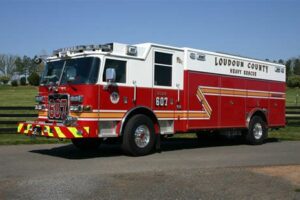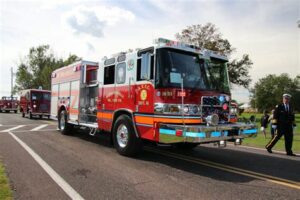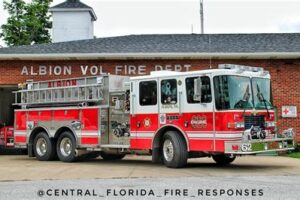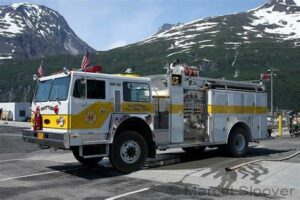Table of Contents
The history of volunteer fire departments dates back centuries, highlighting the selflessness and dedication of individuals who protect their communities. This article delves into the origins, growth, and significance of these organizations, shedding light on the invaluable role they play in firefighting and emergency response. Discover how volunteers have shaped fire departments and continue to serve as vital pillars of local safety.
Throughout the centuries, communities have relied on the selfless dedication of volunteer firefighters to protect lives and property. From the dusty streets of ancient Rome to the bustling metropolises of modern-day America, these brave individuals have been a beacon of hope during times of crisis. They have stood tall in the face of danger, their courage unwavering as they battled towering infernos and rescued those trapped in perilous situations. As we delve into the history of volunteer fire departments, we uncover a captivating tale of heroism, camaraderie, and the unwavering spirit of service that has defined these remarkable institutions.
The Birth of Volunteer Fire Departments
When we think of fire departments today, we often picture a fleet of red trucks manned by professional firefighters. However, the origins of fire departments trace back to a time when communities relied on the heroic efforts of volunteers. The birth of volunteer fire departments can be traced back to ancient Rome, where citizens formed brigades to combat fires that often devastated the city.
The Impact of Insurance Companies
Fast forward to the late 17th century, and we find a significant development in the history of volunteer fire departments. Insurance companies began to play a crucial role in fire protection. In cities like London and New York, insurance companies formed their own fire brigades to protect the properties they insured. Members of these brigades were typically employees or policyholders, who would respond to fires to minimize property damage.
The Rise of Firefighting Societies
In the early 19th century, firefighting societies emerged as a prominent force in fire protection. These societies were typically composed of volunteers who banded together to provide fire suppression services to their communities. Members of these societies often received training in firefighting techniques and were equipped with rudimentary firefighting tools, such as hoses and hand-operated pumps.
The Cincinnati Fire of 1853
One event that had a significant impact on the growth of volunteer fire departments in the United States was the Cincinnati Fire of 1853. This devastating fire, which destroyed much of the city’s commercial district, highlighted the need for a more organized and efficient firefighting system. As a result, many cities began to transition from volunteer-based departments to professional fire departments.
The Transition to Professional Fire Departments
By the late 19th century, the transition from volunteer fire departments to professional fire departments was well underway. Improved technology, such as steam-powered fire engines, made it more feasible to establish paid fire departments. Additionally, the growth of urban areas and the increasing complexity of firefighting operations necessitated a more organized and disciplined approach to fire protection.
The Enduring Role of Volunteer Fire Departments
Despite the rise of professional fire departments, volunteer fire departments have continued to play a vital role in many communities. They often serve rural areas or smaller towns where resources may be limited. Volunteer firefighters receive training and dedicate their time and energy to protecting their communities. Their commitment and selflessness make them an essential part of the firefighting landscape.
Modern Challenges and Innovations
In recent years, volunteer fire departments have faced numerous challenges. A decline in the number of volunteers, increased training requirements, and financial constraints have strained these organizations. However, many departments have embraced technological advances to enhance their capabilities. The use of specialized equipment, communication systems, and advanced training programs has helped volunteer fire departments overcome some of these challenges.
A Symbol of Community Spirit
Volunteer fire departments not only provide fire protection but also serve as a symbol of community spirit and resilience. They bring neighbors together, foster a sense of unity, and demonstrate the power of individuals coming together for a common cause. The dedication and sacrifice of volunteer firefighters continue to inspire and remind us of the importance of community support.
Recognition and Support
Recognizing the critical role played by volunteer fire departments, many communities and governments have implemented measures to support these organizations. This support includes grants, tax incentives, and improved access to training and resources. By acknowledging and valuing the contributions of volunteer firefighters, we can ensure the continued strength and effectiveness of these essential community institutions.
The Legacy of Volunteer Fire Departments
The history of volunteer fire departments is a testament to the human spirit and the power of individuals to make a difference. From ancient Rome to modern-day communities, volunteers have risen to protect lives and property in the face of danger. Their legacy lives on, reminding us that ordinary people can accomplish extraordinary feats when united by a shared purpose.
A Historical Overview of Volunteer Fire Departments
Subtitle 1: The Early Origins of Community Firefighting
Volunteer fire departments trace their roots back to ancient civilizations, where communal efforts were employed to combat fires. From the Roman Empire’s watchers of the city to the bucket brigades of medieval European towns, early forms of firefighting relied on the selfless dedication of volunteers who protected their communities from the devastating effects of fires.
Subtitle 2: The Birth of Volunteer Fire Companies in America
In colonial America, the establishment of volunteer fire companies can be attributed to the scarcity of professional firefighters and the rapid urbanization during the 18th century. Inspired by mutual aid societies in Europe, citizens organized themselves into volunteer fire brigades, laying the foundation for the development of formalized department structures we know today.
Subtitle 3: The Role of Volunteer Firefighters in Industrialized Cities
As the industrial revolution transformed cities into thriving metropolises, the need for more structured fire protection became evident. Volunteer fire departments gained prominence during this period, with workers from factories, mills, and various trades stepping up to protect their communities. These early volunteer firefighters faced hazardous conditions, often combating fires without proper equipment or training.
Subtitle 4: Challenges Faced by Volunteer Fire Departments in the 19th Century
During the 19th century, volunteer fire companies faced numerous challenges, including political manipulation, rivalry between departments, and the rise of political machines. Despite these obstacles, volunteer firefighters continued to serve their communities selflessly, often risking their lives to extinguish fires and safeguard their neighborhoods.
Subtitle 5: The Transition Towards Modern Volunteer Fire Departments
The turn of the 20th century saw the gradual professionalization of firefighting services, marking a transition from purely volunteer-based departments to paid fire companies. However, countless communities, particularly in rural areas and smaller towns, still rely on dedicated volunteers who continue to uphold the noble tradition of volunteer firefighting.
Subtitle 6: The Emergence of Volunteer Firefighters as Heroes
Throughout history, volunteer firefighters have been celebrated and revered for their bravery and selflessness. These individuals often face dangerous situations that demand resilience and courage, becoming true local heroes within their communities. Their unwavering commitment to safeguarding lives and property embodies the spirit of volunteerism.
Subtitle 7: Modern Challenges and Advancements in Volunteer Fire Departments
In today’s fast-paced and technologically driven world, volunteer fire departments face unique challenges. Recruiting and retaining dedicated volunteers, the need for specialized training, and maintaining advanced firefighting equipment pose ongoing hurdles. Nonetheless, these departments continue to thrive, adapting to changing landscapes and employing innovative tactics to ensure public safety.
Subtitle 8: The Legacy and Future of Volunteer Fire Departments
Volunteer fire departments occupy a significant place in the history of firefighting, leaving an enduring legacy of civic duty and community service. While the dynamics of fire protection have evolved over time, the indispensability of volunteer firefighters remains steadfast. As we look to the future, it is crucial to recognize and support these remarkable individuals who epitomize the true spirit of volunteerism and selfless sacrifice.
The history of volunteer fire departments is a fascinating tale that dates back centuries. These dedicated groups of individuals have played a crucial role in safeguarding communities from the devastating effects of fires. In this article, we will delve into the origins of volunteer fire departments, their evolution over time, and their enduring importance.
The birth of volunteer fire departments:
Volunteer fire departments can be traced back to ancient Rome, where citizens formed organized groups to combat fires. However, it was not until the early 18th century that the concept of volunteer fire departments gained significant momentum.
In America, Benjamin Franklin played a pivotal role in establishing the first volunteer fire company in Philadelphia in 1736, known as the Union Fire Company. This marked the beginning of a new era in firefighting, as other cities followed suit and formed their own volunteer fire departments.
The evolution of volunteer fire departments:
As cities grew, so did the need for more advanced firefighting techniques and equipment. Volunteer fire departments adapted to these changing circumstances by embracing technological advancements.
In the 19th century, the introduction of hand-drawn fire engines and later steam-powered apparatuses revolutionized firefighting. Volunteer firefighters eagerly embraced these innovations, ensuring their departments remained at the forefront of fire suppression efforts.
Community involvement and camaraderie:
One of the defining characteristics of volunteer fire departments is the strong sense of community they foster. Volunteers are ordinary citizens who selflessly dedicate their time and effort to protect their neighbors and property.
Joining a volunteer fire department often becomes a lifelong commitment for many individuals. The bonds formed within these organizations are incredibly tight-knit, creating a unique camaraderie that extends beyond the realm of firefighting.
The enduring importance of volunteer fire departments:
Even in today’s modern world, volunteer fire departments continue to play a vital role in fire protection. Their presence ensures that communities, particularly in rural areas, have access to prompt and effective firefighting services.
Volunteer firefighters undergo rigorous training to develop their skills and stay up-to-date with the latest firefighting techniques. Their dedication and passion for serving their communities make them an invaluable asset in times of crisis.
In conclusion, the history of volunteer fire departments is a testament to the strength of community spirit and the unwavering commitment of individuals to protect their fellow citizens. From humble beginnings to the present day, these brave volunteers have stood as guardians against the destructive force of fires. Their legacy serves as a reminder of the power of unity and selflessness in safeguarding our communities.
Thank you for joining us on this journey through the captivating history of volunteer fire departments. From their humble beginnings to their crucial role in safeguarding communities, these dedicated men and women have left an indelible mark on society. As we conclude our exploration, let us reflect on the significant milestones and enduring legacy of these selfless volunteers.
Firstly, it is important to acknowledge the origins of volunteer fire departments. Dating back to ancient Rome, where citizens would form bucket brigades to combat fires, the concept of community-based firefighting has evolved over centuries. Transitioning from rudimentary methods to more organized and sophisticated approaches, these early efforts laid the foundation for the modern volunteer fire departments we know today.
Throughout history, volunteer fire departments played a pivotal role in shaping our communities. During the industrial revolution, as cities expanded and new challenges emerged, these volunteers became the backbone of fire protection services. Their unwavering commitment and willingness to risk their lives for the greater good became the epitome of selflessness. Transitioning into the 20th century, fire departments across the globe saw advancements in equipment and training, ensuring that these volunteers were better equipped than ever before.
Lastly, let us recognize the lasting impact of volunteer fire departments. Their legacy lives on, not only through the countless lives and properties they have saved but also through the sense of unity and camaraderie they foster within communities. These brave men and women continue to inspire future generations to serve their communities and dedicate themselves to the noble cause of fire protection. As we bid farewell to this chapter in history, may we never forget the invaluable contributions of volunteer fire departments and the selfless individuals who have upheld their noble traditions.
Thank you once again for joining us on this enlightening journey through the history of volunteer fire departments. We hope that this exploration has deepened your appreciation for the sacrifices made by these brave men and women. As we move forward, let us continue to support and honor the volunteer fire departments that protect us day and night, ensuring our safety and peace of mind.
.
People Also Ask about the History of Volunteer Fire Departments:
When did volunteer fire departments start?
Volunteer fire departments have a long history, dating back to ancient Rome. However, the modern concept of organized volunteer fire companies emerged in the United States in the early 18th century.
What led to the formation of volunteer fire departments?
The formation of volunteer fire departments was primarily driven by the need for community-based firefighting services. In the early days, cities lacked formal fire departments, and citizens recognized the necessity of collective action to combat fires effectively.
How did volunteer fire departments operate in the past?
In the past, volunteer fire departments relied on dedicated citizens who would respond to alarms using hand-drawn or horse-drawn equipment. These volunteers underwent training and established hierarchies within their departments to ensure efficient firefighting operations.
What challenges did early volunteer fire departments face?
Early volunteer fire departments faced various challenges, including limited resources, inadequate equipment, and the need for rapid response. Additionally, competition between different volunteer companies often arose, leading to rivalries and occasional conflicts.
How did volunteer fire departments evolve over time?
Over time, volunteer fire departments evolved through advancements in technology and changes in firefighting techniques. The introduction of steam-powered engines, motorized vehicles, and improved communication systems revolutionized the way these departments operated.
Are volunteer fire departments still relevant today?
Absolutely. Volunteer fire departments continue to play a vital role in many communities worldwide. Despite the existence of professional fire departments, volunteers often provide valuable supplementary services, particularly in rural areas with limited resources.
How can someone join a volunteer fire department?
To join a volunteer fire department, individuals typically need to meet certain requirements, such as age restrictions and physical fitness standards. Interested individuals should reach out to their local volunteer fire department to inquire about recruitment procedures.
What training do volunteer firefighters receive?
Volunteer firefighters undergo extensive training, which includes learning firefighting techniques, handling equipment, understanding emergency medical procedures, and improving communication skills. The level of training may vary depending on the specific department and jurisdiction.
By answering these commonly asked questions, we can gain a better understanding of the history and significance of volunteer fire departments. These dedicated individuals have played a crucial role in protecting communities for centuries, and their contributions continue to be invaluable.






